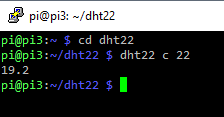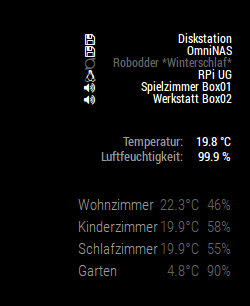working likea charm.
Thanks a lot.
Let’s see what the WAF barometer will say.
Nothing good i guess.
At least mit little daughter is still to little to see the scary eye ;)
working likea charm.
Thanks a lot.
Let’s see what the WAF barometer will say.
Nothing good i guess.
At least mit little daughter is still to little to see the scary eye ;)
Runs perfect on a Win 10 x64.
One thing for me is, i don’t like the fullscreen, because i want to test some stuff before i bring it to the real MM.
Try instead of
“npm start” a
“node serveronly”
This launches the MM not in full screen. You can point now to your browser and type
localhost:8080
This will show your MM installation in your favourit browser.
In my case, the better option :)
First step i would do, is a replacement with another power supply.
Does it have enough power. At least 2.5A is recommened i guess!?
I guess it is not related to the MM itself, its a Pi problem.
so you first installed the sensor and testet the output with
sudo ./dht22 c 22
and
sudo ./dht22 h 22
Please check if your wiring is correct in the wiringPi numbering.
If your sensor is connected to GPIO 22this should work.
Mine does (exept the humidity mostly shows 99.9%, but seems like a sensor issue)
The tutorial you linked is way to complicated in our case. Just do it like it is described in
https://github.com/nebulx29/dht22
hmm. looks not so bad.
It can take some time to read the sensor (~3-5 sec). But i guess you waited longer after the command?
My DHT22 looks slightly different, an i had to solder a resistor between two pins.
Maybe yours is ready made.
Are you sure that 3.3V are enough? You could try to put your + line to pin 2 or 4 (right next to the ground)
Should look like this;)

hah, that would have been my next suggestion… take the xiaomi stuff.
You can jsut throw it everywhere in your house, and you don’t need a wired connection.
Here in the bottom.
As you can see the humidity from the sensor is not showing correctly. Need to buy another one or … even better take another Xiaomi sensor ;)

Don’t forget, that you need the Xiaomi Gateway in order to get the stuff to work
Usually the OS in the background should autodetect the resolution of the TFT.
If not and you are already autostarted the MM system, try to
pm2 stop
via SSH
and try to change the resolution manually on the running Linux.
(Maybe you can add temporarily a mouse to the pi or log in remotely via VNC)
VNC can be enabled via SSH within the console (sudo raspi-config)